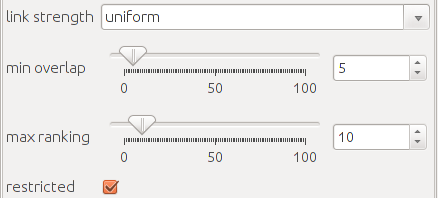Triadic cohesion clustering
Note: this page documents a visone functionality that will be in the next release.
More background information is presented at XXXIII Sunbelt Social Networks Conference of the International Network for Social Network Analysis (INSNA), Hamburg, Germany, May 21-26, 2013:
- Bobo Nick, Conrad Lee, Pádraig Cunningham, Ulrik Brandes: "Triadic Cohesion in Social Networks"
Please address questions and comments to Bobo Nick.
Where to find
Access is given via the analysis tab in the left-hand side of the visone window: set level to grouping, set class to clustering, and set measure to triadic cohesion clustering (TCC).
How to use
Configuration
link strength
For each node, the algorithm will rank its neighborhood (outgoing links) according to the provided link strength attribute.
- If uniform is selected (default), links are first weighted according to their Simmelian strength and afterwards ranked according to this newly created link attribute (termed triadType300).
- Otherwise, the rankings will be calculated according to the link strength attribute that was provided.
min overlap
This parameter allows to specify a threshold for the minimal required overlap for a link not to be removed from the network; see next paragraphs for more information on the calculation of the overlap. Setting min overlap to zero will imply that the overlap value has no effect with regard to removing links from the network.
max ranking
Given a pair of nodes, the algorithm will calculate the overlap of top-ranked other nodes in their neighborhoods. You can use the max ranking parameter to specify the maximum rank which is still reagrded as top-rank. That is, those neighbors that have been attached a rank greater than max ranking will be disregarded when calculating the overlap. (Setting max ranking to zero will imply zero/undefined overlap values.)
restricted
Use this parameter to define for which pairs of actors the overlap of top-ranked neighborhoods is calculated:
- if selected (default), the overlap calculation is restricted to those links which have been top-ranked themselves
- if de-selected, the overlap calculation is performed for each pair of connected actors
Execution and result
The resulting neighborhood rankings are saved in a link attribute termed rank, the resulting overlap values are saved in a link attribute termed overlap.


